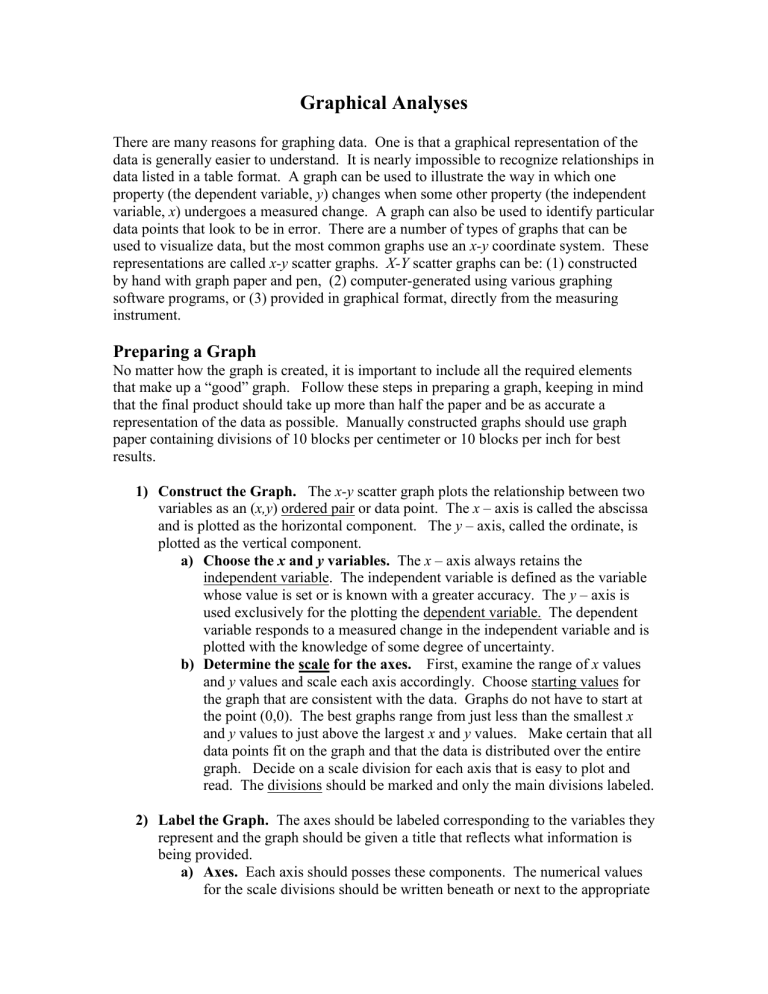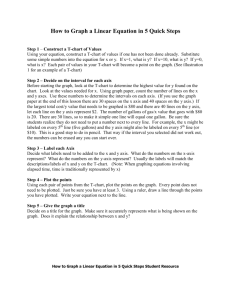Graphical_Analyses

Graphical Analyses
There are many reasons for graphing data. One is that a graphical representation of the data is generally easier to understand. It is nearly impossible to recognize relationships in data listed in a table format. A graph can be used to illustrate the way in which one property (the dependent variable, y ) changes when some other property (the independent variable, x ) undergoes a measured change. A graph can also be used to identify particular data points that look to be in error. There are a number of types of graphs that can be used to visualize data, but the most common graphs use an x-y coordinate system. These representations are called x-y scatter graphs. X-Y scatter graphs can be: (1) constructed by hand with graph paper and pen, (2) computer-generated using various graphing software programs, or (3) provided in graphical format, directly from the measuring instrument.
Preparing a Graph
No matter how the graph is created, it is important to include all the required elements that make up a “good” graph. Follow these steps in preparing a graph, keeping in mind that the final product should take up more than half the paper and be as accurate a representation of the data as possible. Manually constructed graphs should use graph paper containing divisions of 10 blocks per centimeter or 10 blocks per inch for best results.
1) Construct the Graph.
The x-y scatter graph plots the relationship between two variables as an ( x,y ) ordered pair or data point. The x – axis is called the abscissa and is plotted as the horizontal component. The y – axis, called the ordinate, is plotted as the vertical component. a) Choose the x and y variables. The x – axis always retains the independent variable. The independent variable is defined as the variable whose value is set or is known with a greater accuracy. The y – axis is used exclusively for the plotting the dependent variable. The dependent variable responds to a measured change in the independent variable and is plotted with the knowledge of some degree of uncertainty. b) Determine the scale for the axes. First, examine the range of x values and y values and scale each axis accordingly. Choose starting values for the graph that are consistent with the data. Graphs do not have to start at the point (0,0). The best graphs range from just less than the smallest x and y values to just above the largest x and y values. Make certain that all data points fit on the graph and that the data is distributed over the entire graph. Decide on a scale division for each axis that is easy to plot and read. The divisions should be marked and only the main divisions labeled.
2) Label the Graph. The axes should be labeled corresponding to the variables they represent and the graph should be given a title that reflects what information is being provided.
a) Axes. Each axis should posses these components. The numerical values for the scale divisions should be written beneath or next to the appropriate
mark for the x – axis and y – axis, respectively. Numbers should never be crowded together. Label every other division if it is necessary. Make sure that the values reported in the scale retain the same number of place holders as found in the tabulated data. An axis label, stating what is plotted on that axis should appear below or next to the axis scale including any appropriate units of measure. The units are written inside parentheses. b) Graph Title.
The title may be positioned either at the top or bottom of the graph. The title should not repeat the axes information but supply information regarding the purpose of the graph or how the plot will be utilized.
3) Present the Data. Plot all data points and observe the graphical result.
a) Data Points.
Each data point should be plotted as a small pin-point and then outlined by a small geometric shape. If more than one data set is being plotted, use a different symbol for each set (circle, square, triangle, etc.).
b) Observe the Graph.
Decide if there appears to be a pattern or trend in the graph. An apparent trend in graphical data can be correlated to a relationship between the variables plotted in the graph. Decide what type of trend (curve) best fits the data and decide on a device to aid in drawing that trend. A Ship’s curve, French curves, and rulers may be available.
Draw a smooth curve through the majority of the data points. Every data point will not fall on the curve since each has a degree of experimental error. The whole idea of drawing a graph is to average out the errors in data collection. The “best” curve is defined as the one drawn to minimize the total error in all data points. This is reflected in having all data points an equal distance in the y value from the drawn curve. Sometimes the
“best” curve results in a straight line, a linear function.
4) Linear Data.
Linear graphs are very useful for analyzing data, as they provide for easy interpolation of their solution. If y is the quantity being plotted on the y - axis and x is the quantity plotted on the x – axis, the equation of the resulting straight line is: y = mx + b . If you are using a graphing program or graphing calculator, both should calculate and draw the best straight line for the data set.
These devices are also capable of providing the linear equation of best fit.
a) Slope.
The notation m represents the slope of the line. The slope of the line is equal to the change in y for a defined change in x (Δ y
/Δ x ). In order to solve for the slope, identify two points ( x
1
, y
1
) and ( x
2
, y
2
) that are positioned directly on the line that was previously drawn. These points may not be actual data points, but positions on the line. Imagine moving from point ( x
1
, y
1
) to point ( x
2
, y
2
) using only one horizontal and one vertical move. The right triangle formed by these two moves is called the slope triangle. It gives shows the horizontal and vertical change for movement from one point to another. The ratio of the vertical change to the horizontal change equals the slope of the line, m . This can be written mathematically as:
m
( y
2
( x
2
y
1
) x
1
) b) Y – intercept . The notation b represents the y -intercept. The y - intercept is the value of y defined at x = 0. c) Use of the Linear Equation. Once the linear equation is solved for, it can be used to find the relationship in the dependent variable if the independent variable is given. That is, if a value for x is substituted into the equation y = mx + b the value of y can be solved for.
5) Graphical Example.
Figure 1 provides an example of the graphical presentation of the data reported in Table 1, below. Table 1 lists information used to create a graph for the relationship between mass of a material and its volume. Figure 1 has been created using the software program, Microsoft Excel
. It is apparent that the mass is related to the volume using a linear trend; the majority of the data points lie on the line created by the software.
Table 1. Mass/Volume Data Obtained for Deionized Water at Room
Temperature.
Mass Water (g) Volume Water (ml)
0.998
0.804
0.595
0.398
0.190
1.000
0.800
0.600
0.400
0.200
Relationship of Mass to Volume of Deionized Water
1.400
1.200
y = 0.989x + 0.0096
R
2
= 0.9999
1.000
0.800
0.600
0.400
0.200
0.000
0.000
0.200
0.400
0.600
0.800
1.000
1.200
Volume (ml)
Figure 1.
Relationship of Mass to Volume of Deionized Water.
Analyzing a Graph
It is important to be able to read a graph and remove information from it. Look at all the components of the graph to obtain information about the data. Observe the title of the graph and the titles of each axis. Observe the units of each axis. Determine the scale used and how many place holders can be read from the graph. It is important to correctly abstract information from a graph.








